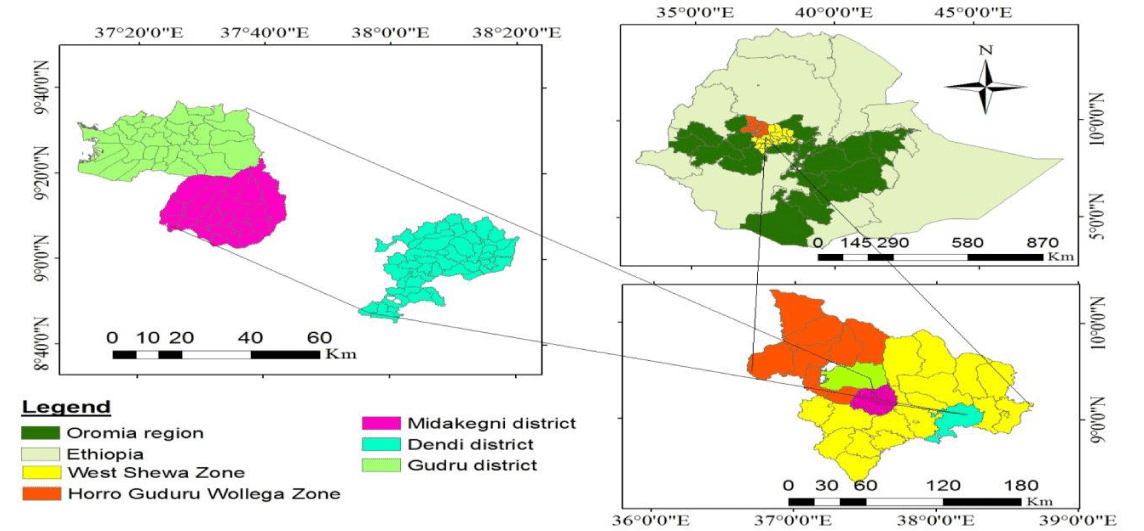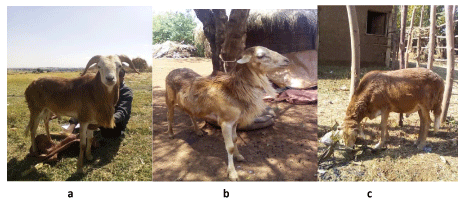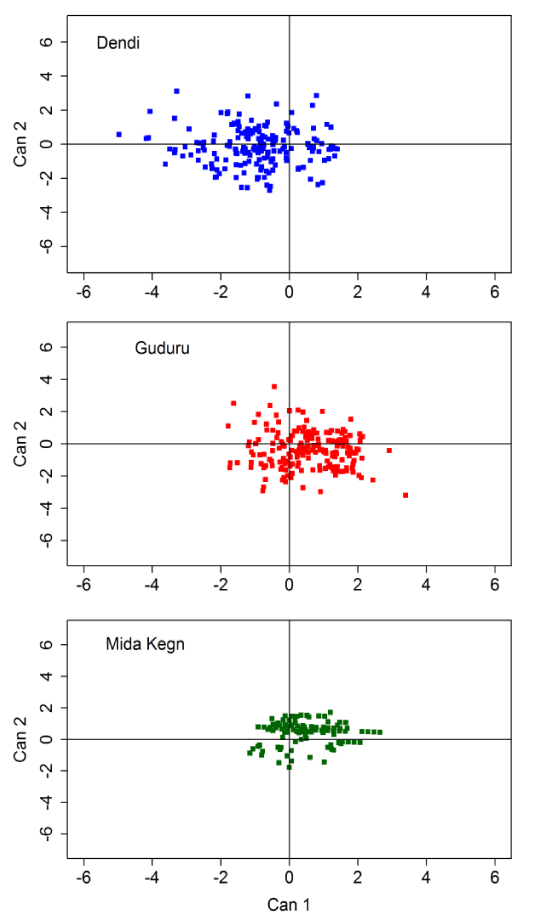International Journal of Agricultural Science and Food Technology
Multivariate analysis of phenotypic traits of indigenous sheep revealed new population in western part of Ethiopia
Gobena Wagari1*, Tesfaye Getachew2 and Elias Bayou3
2International Center for Agricultural Research in the Dry Areas (ICARDA), Addis Ababa, Ethiopia
3Department of Animal Science, College of Agriculture and Natural Resources, Mizan Tepi University, P. O. Box 260, Mizan Teferi, Ethiopia
Cite this as
Wagari G, Getachew T, Bayou E (2020) Multivariate analysis of phenotypic traits of indigenous sheep revealed new population in western part of Ethiopia. Int J Agric Sc Food Technol 6(1): 050-057. DOI: 10.17352/2455-815X.000055This study was carried out to phenotypically characterize and differentiate sheep populations of Western part of Ethiopia. Physical observations and body weight and linear measurements were studied. Multivariate canonical and discriminant analysis were employed to differentiate population. Three districts; Dendi, Guduru and Mida Kegn districts were selected purposely based on sheep production potential and previous characterization studies. For example, majority of male sheep in Dendi district had horn while majority are polled in Guduru and Mida Kegn districts. The two canonical variates extracted explain a total of 100% of the total variation (80.6% by Can1 and 19.4% by Can2). The Can1 and Can2 presented high weighing for ear length and pelvic width, respectively. It showed that these traits demonstrating their importance to discriminate and to classify the sheep population in the areas. Sheep population of Dendi, Guduru and Mida Kegn districts were correctly grouped into their own geographical area for about 71.15%, 54.62% and 69.23%, respectively. The largest mahalanobis distance was found between sheep population in Dendi and Guduru (2.27). The smallest distance was found between Guduru and Mida Kegni with mahalanobis distance of 0.649. These results showed that sheep population in Dendi was found to be unique and confirmed the existence of two populations (Dendi and Guduru-Mida Kegn) in the study area.
Introduction
Ethiopia has a diverse sheep population and its distribution is paralleled with its diverse ecology. According to CSA (2016/17) [1] report, 30.7 million sheep are estimated to be found in the country with at least 9 sheep breeds and 14 traditional sheep populations [2]. Despite low level of productivity due to several technical (genotype, feeding and animal health), institutional, environmental and infrastructural constraints [3], indigenous sheep breeds have great potential to contributing more to the livelihoods of the people in low-input, small-holder crop livestock and pastoral production systems [4].
According to Kassahun and Solomon [5], Horro sheep breed is widely distributed in Shewa to East and West Wollega, Illubabor and Jimma zones of Oromia Region. These areas encompass different agro-ecological conditions, marketing outlets and also cover wide areas. Characterization attempt so far were based on sampling known breeds from their main breeding tract without giving focus to populations far from the breeding tract. Dispersion of sheep population to different agro-ecologies or environments and distance from the main breeding tract might cause population stratification and morphological differences among populations. Study on three districts of South Wollo area revealed that the existence of body weight and body measurement variations which might be evidence of population stratification in Wollo sheep breed [6]. Notable variation among indigenous population was observed within Wollo sheep population. This variation might be due to environment and /or genotype. Phenotypic comparison based on morphological characters can provide to an extent a reasonable representation of genetic differences among populations. Multivariate analyses of morphological traits have been proved to be suitable in assessing genetic variation within and between populations when all morphological variables are considered simultaneously. Discriminant analysis encompasses procedures for classifying observations into groups and describing the relative importance of variables for distinguishing among groups [7]. In this study, an attempt has been made to phenotypically characterize and differentiate sheep populations of western part of Ethiopia i.e. West Shewa and Horro Guduru Wollega zones based on phenotypic traits, using canonical discriminant analysis to see whether they are similar or distinct.
Although large number of sheep found in West Shewa [1], information on the morphological characteristics of sheep is limited. This population was classified under Horro sheep breed and most of the characterization and research interventions are focus in Horro Guduru Wollega Zone. However, there was a hypothesis that the sheep breed in West Shewa particularly in and around Dendi district exhibit different morphological character. Thus, conducting this study is useful to plan different developmental strategies like community-based genetic improvement program, to obtain better knowledge of their present and potential future uses for food and agriculture in defined environments, and to recognize indigenous sheep exist in and around Dendi district as morphologically distinct sheep breed from or similar with Horro sheep breed based on their phenotypic traits. Thus, this study was aimed to describe qualitative and quantitative characteristics of indigenous sheep breeds and to investigate phenotypic variation among geographical areas using canonical discriminant analysis in different location of western Ethiopia.
Materials and methods
Description of the study area
The study was conducted in three districts; Dendi and Mida Kegn districts of West Shewa Zone and Guduru district of Horro Guduru Wollega zone of Oromia Regional State. Horro Guduru Wollega zone is located at about 310 km of Addis Ababa. The area lies between 9010’53’’N-10017’03’’N and 36039’36’’E-37040’13’’E latitude and longitude, respectively [8] Figure 1.
Sampling technique
Dendi, Guduru and Mida Kegn districts were selected purposively for this study. Guduru district was selected to represent Horro Guduru Wollega area, which is beloved to be the main breeding tract and origin of Horro sheep (Horro area) where most of the previous sheep characterization and interventions were focused on [9]. Dendi district was selected to represent Ginchi sheep (central highland sheep) which is well known in Addis Ababa market. Mida Keng district was selected as the area found between Guduru and Dendi and population sampled from this district were helped to assess how the morphological characters behave as we move from Guduru to Dendi district in other way from Horro Guduru Wollega to West Shewa zone. From each district, two rural kebeles were selected purposively considering the sheep flock population. According to FAO [10], physical measurements should be taken only from a representative set of adult animals (as judged by dentition): about 100-300 females and 10-30 males. Based on this, body weight and linear measurements were taken from a total of 780 adult sheep. Each experimental adult animal was classified by sex, district, and dentition. Dentition record was included, as this was the only reliable means to estimate the approximate age of an animal. Adult sheep was classified into two age groups; 1 pair of permanent incisor (1PPI) and ≥ 2 pairs of permanent incisor (2 PPI).
Data collection
Data was collected through field measurement and observations which included morphological characters like: coat color type and pattern, head profile, ear form, presence of wattle and horn, horn shape and orientation and tail shape were observed and recorded using a format developed for the purpose whereas body measurements: chest girth (CG), body length (BL), height at wither (HW), rump height (RH), pelvic width (PW), ear length (EL), horn length (HL), tail length (TL), tail circumference (TC) and scrotum circumference (SC) were collected using tailors measuring tape while body weight was measured using suspended spring balance having 50kg capacity. Linear body measurements were taken by restraining and holding the animals in a stable condition. All measurements were carried out by the same person in order to avoid inter-individual variations.
Statistical analysis
Both qualitative and quantitative data were analyzed by Statistical Analysis System (SAS, release 9.1, 2008). Qualitative data from individual animal observation was analyzed following the frequency procedures of SAS. GLM procedures of SAS were employed to analyze quantitative variables to determine effects of class variables (sex, district and dentition) and their interaction. For adult sheep; sex, district and age group of the sheep and their interaction were fitted as independent variables while body weight and linear body measurements were fitted as dependent variables. Scrotum circumference was analyzed by fitting age group and district as fixed factor.
Model for the least square mean analysis in females and males except scrotal circumference was: Yijk =μ + Di + Aj +Sk + (AxS)jk + eijk
Where: Yijk = Observed body weight or linear body measurements, μ = Overall mean, Di = the fixed effect of ith district (Dendi, Guduru, Mida Kegn), Aj = the fixed effect of jth age classes (1PPI, ≥2PPI), Sk= the fixed effects of kth sex (male, female), (AxS)jk=the interaction effects of jth age and kth sex and eijk= random residual error
Model for the least square mean analysis in males for scrotal circumference was:
Yij =μ + Di +Aj + eij
Where: Yij = Observed/measured scrotal circumference, μ = Overall mean, Di = the fixed effect of ith district (Dendi, Guduru, Mida Kegn), Aj = the fixed effect of jth age classes (1PPI, ≥2PPI) and eij= random residual error
Stepwise discriminant procedure was applied using PROC STEPDISC to determine which phenotypic traits have more discriminant power than others. The relative importance of the morphometric variables in discriminating of indigenous sheep types in the study area was assessed using the level of significance (P<0.05) and partial R2 values ≥0.01. The CANDISC procedure was used for univariate and multivariate one-way analysis that calculate the Mahalanobis distances of the phenotypic traits, and derive canonical functions (linear combinations of the continuous variables that summarize variation of sheep types among the areas. The ability of these canonical functions to assign each individual sheep to its sampling area was calculated as the percentage of correct assignment of each sheep types in each geographical area using the DISCRIM procedure. The number of misclassified individuals indicates the degree of similarities between the populations.
Results and discussion
Characterization of qualitative traits
Description of the physical characteristics of livestock breeds is very important for developing a breeding strategy in a particular production system [11]. The result indicated that all observed morphological characters were significantly associated (P<0.01) with districts except presence of wattle (Table 1). The main frequently observed coat color pattern of sheep were plain 51.9%, 83.1% and 78.8% and the main dominantly observed coat color type were red and white mix (24.6%), brown (48.8%) and brown (42.7%) for Dendi, Guduru and Mida Kegn districts, respectively. Current study result on qualitative traits of Horro sheep is in line with the previous work done by Zewdu [9]. Straight head profile 85.8%, 96.2% and 95.0% were mainly observed for sheep in Dendi, Guduru and Mida Kegn districts, respectively. The presence of horn was the main unique characteristics of male sheep in Dendi/Ginchi male sheep (96.7%) than for Guduru and Mida Kegn sheep. Spiral horn shape (89.7%) and lateral orientation of horn (89.7%) were observed for male sheep in Dendi district. Majority of sampled sheep population in Dendi (54.2%) possesses cylindrical and twisted at end, whereas in Guduru (80.0%) and Mida Kegn (81.2%) possesses cylindrical and straight tail shape. The most ear form of sheep observed was semi-pendulous 50.8%, 82.3% and 88.5% for Dendi, Guduru and Mida Kegn sheep populations, respectively. Wattle absence 92.7%, 95.4% and 95.7% was observed for Dendi, Guduru and Mida Kegn districts, respectively. Typical sheep types of the study areas are presented in Figures 2.
Live body weight and linear measurements
Information on live body weight and linear measurements of the existing breed types has a vital role in the selection Program [6].
District effect
There was significant difference for body weight and all recorded linear body measurements (P<0.01) among the districts. Average least squares means and standard errors of body weight and chest girth were 29.4±0.23, 28.2±0.23 and 29.8±0.24 for sheep in Dendi, Guduru and Mida Kegn, respectively (Table 2). Highest body weight was obtained for Dendi and Mida Kegn districts than Guduru district. It attributed to genetic as well as management difference. Feed shortage problem was more prevalent in Guduru district rather than Dendi and Mida Kegn districts. The current result of live body weight of sheep in Guduru district almost related with Zewdu [9] report; the body weight of Horro sheep was 27.65 ± 0.21. Highest value of ear length was obtained for Guduru (11.8±0.8) and Mida Kegn (11.7±0.7) sheep than for Dendi sheep (10.9±0.7). This implies that sheep in Dendi has shorter ear than sheep in Guduru and Mida Kegn. This show as the sheep population in Dendi is unique from the other population (Guduru and Mida kegn). Height at wither of Guduru sheep (69.6±0.20) and Mida Kegn (69.8±0.19) was higher than Dendi sheep (68.0±0.24) and also tail length was higher for Guduru sheep and Mida Kegn than Dendi sheep. This implies that sheep in Dendi has shorter ear than sheep in Guduru and Mida Kegn. The differences in body measurements among flocks in Guduru and Dendi and Mida Kegn and Dendi and the similarity among flocks in Guduru and Mida Kegn might indicate that sheep breed in Dendi and the other districts are different and sheep population in Guduru and Mida Kegn were however are same breed.
Sex effect
Sex of animals had significant effect (P<0.01) on the linear body measurements and live body weight. Highest body length, body weight, chest girth, height at wither, rump height, tail length and tail circumference except pelvic width and ear length were recorded for male sheep. The recorded body weight in this study for males and females was 31.0±0.28 and 26.4±0.16 kg, respectively (Table 2). Ear length 11.8±0.40 and 10.9±0.08 was obtained for females and males sheep, respectively. Similarly, Taye, et al. [11] reported that the overall least square mean body weight, heart girth, body length and height at rump were affected by sex.
Age effect
Body weight and all recorded linear body measurements were significantly (P<0.01) affected by age group of animal. All measured traits show an increment with age of animal. Body weight 26.6±0.22 and 31.7±0.24, chest girth 71.0±0.24 and 76.0±0.26 were recorded for 1PPI and 2PPI age of group of animals, respectively (Table 2). Similarly, Kenfo, et al. [12-18] reported body weight of indigenous sheep (both sexes) showed an increment with an increase in age of the animals.
Age by sex effect
Age by sex interaction had significant effect (P<0.01) on EL, TL, and TC. However, the effect (P>0.05) was not observed on BL, BW, HW, RH, and PW. Large ear and tail length and tail circumference value were recorded for male sheep ≥2PPI, whereas high ear length was recorded for female sheep ≥2PPI.
Multivariate analysis
Stepwise discriminant analysis: Step-wise discriminant analysis was first applied to select the most important discriminator variables used for differentiation among sheep types under study. The result of the stepwise discriminant analysis is presented in Table 3. All of the nine variables considered in the analysis were found to be significant (P<0.01 and Partial R2 >0.01 to P<0.0001 and Partial R2 0.1181). Ear length was found to be the most discriminating trait followed by body length, chest girth, height at wither and pelvic width in decreasing order of discriminating power. This implies that taking these basic measurements (EL, BL, CG, HW and PW) consistently could be more important in differentiating between the three geographical areas than acquiring numerous additional measurements.
Canonical discriminant analysis: The univariate and multivariate test statistics are presented in Tables 4,5, respectively. The univariate statistic testing shows that all variables are highly significant (P<0.0001) except chest girth (P<0.001). The resulting partial R2 values ranged from 0.0173 for chest girth to 0.1181 for ear length. The multivariate test for differences among the districts is also highly significant (P<0.0001), in all of the four types of multivariate tests (Wilks’ Lambda, Pillia’s Trace, Hotelling-Lawley Trace, and Roy’s Greatest Root).
The total canonical structure, canonical correlation and total variation explained by each canonical variable for sheep populations are presented in Table 6. In this study, canonical discriminant analysis showed how each trait aligned to the two canonical variations; weighing each original trait according to its contribution on each canonical variable. The first canonical variable explained 80.6% of the total variation and Can2 explained 19.4% of the total variation, the two canonical varieties extracted explains a total of 100% of the total variation. EL, HW and RH had higher weighing in extracting Can1 while PW, BW and BL loaded high in Can2. The first and second canonical variables presented high weighing for ear length and pelvic width, respectively. It showed that these traits demonstrating their importance to discriminate and to classify the sheep population in the area. Canonical discriminant analysis measures the strength of the overall relationship between the linear composite of the predictor and criterion set of variables. In this analysis the predictor is the canonical variate and the criterion is the sheep population. The significant canonical correlation between the sheep population and the first canonical variate (rc =0.554) and the sheep population and the second canonical variate (rc=0.311), indicate that the canonical variate explain the differentiation of the sheep population, though the first Can1 was more into explaining the most of the variation. Canonical variates (can1 and can2) explain the differentiation of the sheep population is showed in Figure 3.
Discriminant analysis: Discriminant function analysis to determine the percentage of individuals correctly grouped into their own geographical area is presented in Table 7. The results indicate that 65% of sheep populations were correctly grouped into their location, whereas the error count estimates was 35%. Dendi, Guduru and Mida Kegn were correctly grouped into their own geographical area for about 71.15%, 54.62% and 69.23%, respectively.
Mahalanobis distance matrix among districts is presented in Table 8. Mahalanobis distance was estimated from the mean values of variables having more discriminant power. All pair wise distances were significant (P<0.0001). The largest distance was found between sheep found in Dendi and Guduru, and Mida Kegn, which was 2.27 and 2.01 distance, respectively. This implies that sheep in Dendi district vary on those measured linear body measurements from sheep in Guduru and Mida Kegn district. However, the smallest distance was found between Guduru and Mida Kegni district with mahalanobis distance of 0.649 indicating the sheep populations in the two districts are same breed.
Conclusion
Morphological features of sheep population in Dendi were different from features of Horro sheep. The largest distance was found between sheep found in Dendi and Guduru and Mida Kegn. Largest distance was observed between sheep in Dendi and other population. The current work revealed that, sheep populations in Mida Kegn and Guduru areas are belong to the same breed (Horro). In general, this result showed that sheep population in Dendi was found to be unique in morphological and quantitative measurements from those sheep population found in Guduru and Mida Kegn districts. However, sheep populations found in the later two districts are same breed. Multivariate canonical analysis and morphological trait variation confirmed the existence of two populations (Dendi and Guduru-Mida Kegn) in the study areas.
- SA (Central Statistical Agency of the Federal Democratic Republic of Ethiopia) Agricultural Sample Survey of 2016/17 (2009 E.C).Volume II. Report on Livestock and Livestock Characteristics (Private Peasant Holdings), Central Statistical Agency, Addis Ababa, Ethiopia.
- Gizaw S, Komen H, Hanotte O, Van Arendonk JAM (2008) Indigenous sheep resources of Ethiopia: types, production systems and farmers preferences. Anim Genet Res Inf 43: 25-39. Link: https://bit.ly/3h0rVga
- Tibbo M (2006) Productivity and health of indigenous sheep breeds and crossbreds in the central Ethiopian highlands. Ph D. Thesis. Swedish Univ. Uppsala, Sweden. Link: https://bit.ly/2UdfJyI
- Kosgey IS, Okeyo AM (2007) Genetic improvement of small ruminants in low-input, smallholder production systems: Technical and infrastructural issues. Small Rumin Res 70: 76-88. Link: https://bit.ly/2XyIgRd
- Kassahun A, Solomon A (2006) Breeds of sheep and goats. Sheep and goat production Handbook for Ethiopia. Ethiopian sheep and goat productivity improvement program (ESGPIP) 6.
- Mohammed N, Alemayehu K, Getachew T (2017) On-farm phenotypic characterization of indigenous sheep population and its cross with awassi in selected Districts of South Wollo, Amhara, Ethiopia. Trop Drylands 1: 1–11. Link: https://bit.ly/2MvtBjz
- Lix LM, Sojobi TT (2010) Discriminant analysis for repeated measured data: A Review. Psychology1: 146. Link: https://bit.ly/2zb2LKE
- Olana BT (2006) People and Dams: Environmental and socio- economic changes induced by a reservoir in Fincha water shed Western Ethiopia. PhD Thesis, Wageningen University, The Netherlands. Link: https://bit.ly/2UcKns1
- Zewdu E (2008) Characterization of Bonga and Horro indigenous sheep breeds of smallholders for designing community based breeding strategies in Ethiopia. M.Sc. Thesis submitted to the department of animal science, school of graduate studies, Haramaya University. 33. Link: https://bit.ly/2z4IBlh
- FAO (food and agricultural organization of the united nation), 2012. Phenotypic characterization of animal genetic resources. FAO animal production and health guidelines 91-105. FAO, Rome
- Taye M, Yilma M, Rischkowsky B, Dessie T, Okeyo M, et al. (2016) Morohological characteristcts and linear body measurements of Doyogena sheep in Doyogena district of SNNPR, Ethiopia. Journal Agri Research 11: 4873-4885. Link: https://bit.ly/3dzzxnu
- Kenfo H, Mekasha Y, Tadesse Y (2017) On farm phenotypic characterization of indigenous of sheep type in Bensa district, southern Ethiopia. Journal of biology, Agriculture and healthcare 7. Link: https://bit.ly/2Ubn5Tt
- Agaviezor B, Peter S, Adefenwa M, Yahubu A, Adebambo O, et al. (2012) Morphological and microsatellite DNA diversity of Nigerian indigenous sheep. Anim Sci Biotech 3: 38. Link: https://bit.ly/3dCVphJ
- Aziz MMA, Al-Hur FS (2013) Differentiation between three Saudi goat types using size free Canonical discriminant analysis. Emir J Food Agric 25: 723-735. Link: https://bit.ly/2Y2H5J0
- ESGPIP (2009) Ethiopia Sheep and Goat Productivity Improvement Program]. 2009. Estimation of weight and age of sheep and goats. Technical Bulletin No. 23. Link: https://bit.ly/3dze7ag
- SAS (Statistical Analysis System) (2008) SAS for windows, Release 9.1. SAS Institute, Inc., Cary, NC, USA.
- Tesfaye G (2008) Characterization of Menz and Afar indigenous sheep breeds of smallholders and pastoralists for designing community-based breeding strategies in Ethiopia. MSc thesis. Haramaya, Ethiopia: Haramaya University.
- Younas U, Abdullah M, Bhatti JA, Pasha TN, Ahmad N, et al. (2013) The Journal of Animal and Plant science. Inter-Relationship of body weight with Linear Body Measurments in Hissardale Sheep at Different stages of life.
Article Alerts
Subscribe to our articles alerts and stay tuned.
 This work is licensed under a Creative Commons Attribution 4.0 International License.
This work is licensed under a Creative Commons Attribution 4.0 International License.




 Save to Mendeley
Save to Mendeley
